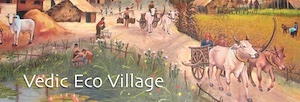The forest adjoins the village and provides a place where all species can coexist. Once some of the original forest was cleared, the Vedic culture also necessitated that another kind of forest be established in its place. This is equivalent to today's "production forests" and it provides the essential goods and services to humans and livestock (e.g., fodder, timber, roots, and herbs, besides maintaining soil fertility, air and water quality as well as providing shelter). Traditionally, these are called Shrivan or the 'forest of prosperity' or 'forest of wealth'.
Our Forest
Working forest (Shrivan)
Coppice forest for firewood and forest hay. This is a Low-grade selection managed forest so we can return to cold fire managed fire protocols. Trees designated for construction purposes or sale are no threat to catastrophic hot fire loss. An abundance of firewood always comes from this sector
Sacred forest (Tapovan)
Designated area (areas) for visiting monks and nuns. Can we design a coppice wood down in the riparian area near the temple?
Wildlife forest (Mahavan)
Elk and Moose must be allowed to return safely to our valley and find refuge here. Identify our elder grandmother and grandfather trees (old growth). The remaining old growth trees both living and dead (snags)(habitat trees)
We need to identify the locations of these ancient trees and create signs for them that explain their significance so fire wood cutters don’t continue to take them. They can become part of an interpretation/educational walk that are on the maps we offer to locals and visitors
